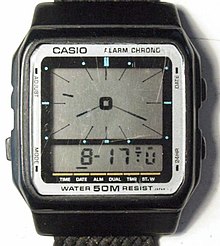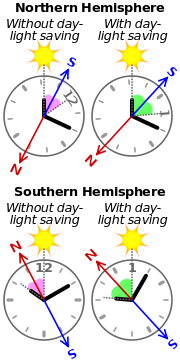Analog clock
An analog clock (also known as a pointer clock ) shows the time using pointers on a dial . In contrast, a digital clock shows the time using a coded character set on a digital display . The term analog clock is a retro name .
Components
The pointer mechanism is an assembly of a mechanical clock and consists of the parts minute wheel, quarter tube (this carries the minute hand above the third wheel), change wheel and hour wheel (this carries the hour hand).
The pointer mechanism transmits the drive to the minute wheel shaft. The minute wheel, the change wheel and the hour tube with change mechanism translate the respective hand speed. The speed of rotation of the minute wheel is reduced via a change wheel and a change gear to the hour tube, which only rotates at one revolution per hour. There is a total transmission ratio of 1:12 or 1:24 between the quarter tube and the hour wheel, depending on a 12-hour or 24-hour scale. The hour hand is attached to the hour tube and the minute hand to the quarter tube. The quarter tube is connected to the minute wheel shaft or the minute tube via a slip clutch. The slip clutch allows you to set the time after pulling the crown.
The clock hands are moved by a clockwork that draws its energy from a wound coil spring or a battery . The spring is wound either by hand or by moving the watch with an automatic winding mechanism . Analog clocks can show other data besides the time, such as: B. day , date , year , or moon phases (see Complication and Grande Complication ).
The pointer is positioned using a pointer actuator.
pointer
The shapes and designs of watch hands are varied, with varying finissages . Since the renaissance of the mechanical watch after the quartz crisis , new types of hands have been developed.
The pointer position can be calculated mathematically, here for a clock with regular 12-hour scale:
- Minute hand angle = number of minutes × 6 °,
- Hour hand angle = number of hours × 30 ° + number of minutes × 0.5 °.
Determination of the compass direction
With the help of an analog clock and the direction of the sun, the compass direction can be determined. In the northern hemisphere, the sun is at noon in the south. If you align the hour hand with the sun on a wristwatch with a 12-hour scale, you will find south on the bisector between the 12 o'clock mark and the hour hand. In summer time , south is on the bisector between the 1 o'clock mark and the hour hand. In the southern hemisphere, the sun is in the north at noon. Instead, the 12 o'clock and 1 o'clock markings are aligned with the sun and north is determined using the bisectors mentioned above.
The non-ideal position of the time zones and the resulting deviation of the local time from the mean solar time can result in minor inaccuracies in determining the direction of the compass. Furthermore, the closer you get to the equator , the worse the method works .
Individual evidence
- ↑ G.-A. Berner: Analog display. In: Illustrated specialist encyclopedia of watchmaking. Association of the Swiss Watch Industry, accessed January 15, 2012 .
- ^ Helmut Kahlert , Richard Mühe , Gisbert L. Brunner : Wristwatches: 100 years of development history. Callwey, Munich 1983; 5th edition, ibid. 1996, ISBN 3-7667-1241-1 , p. 48.
- ^ Helmut Kahlert , Richard Mühe , Gisbert L. Brunner : Wristwatches: 100 years of development history. Callwey, Munich 1983; 5th edition, ibid. 1996, ISBN 3-7667-1241-1 , p. 48.
- ↑ How to find out the cardinal points with the help of a clock. In: Tipscout.de. Tipscout, January 15, 2000, accessed January 15, 2012 .




